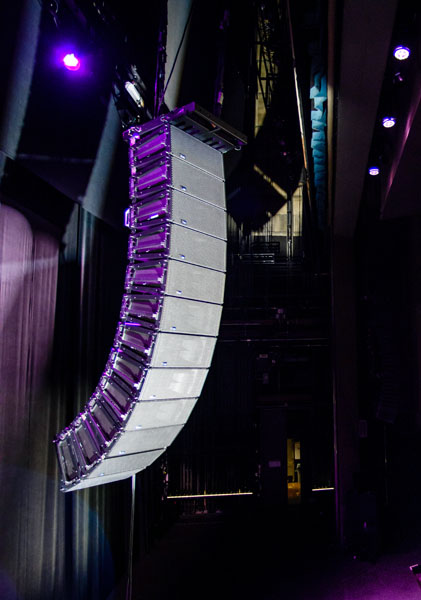Meyer Sound holds that keeping the design, manufacturing, and assembly of its drivers and amplifiers at its Berkeley headquarters is the only path to innovation and product consistency.
Along the way, the company notes that its engineers have also discovered unexpected opportunities by having R&D, manufacturing, and quality assurance right on the same multi-block campus.
Vice president of research and development Pablo Espinosa discusses why Meyer Sound chooses this approach to product development and manufacturing.
Q: What can factory visitors expect to see when they visit the Meyer Sound Berkeley manufacturing facilities?
From the paper cone to the driver suspension and amplifiers, we design and make almost all of the interior speaker components onsite in Berkeley, and all of this is fun for users of our products to see. They also like knowing that each loudspeaker is put together here on campus by hand, rather than on an assembly line in a remote location.
Testing is a critical piece in our manufacturing and this is evident in our factory visits. Each component is individually tested multiple times before the assembled product is compared to a reference speaker to ensure system consistency and reliability. The verification results help inform design and process improvements.
This hyper-attention to detail in the intimately monitored manufacturing processes is unusual in the industry, and something we’re very proud of.
Q: Manufacturing core components in-house is rare in the AV industry. Why does Meyer Sound do it?
Before the mid-1990s, like most other companies, Meyer Sound bought drivers from vendors and modified each one to meet the specs. It soon became clear that this process didn’t give us the design flexibility we needed to push cutting-edge technologies, such as self-powered systems. Also, the inconsistent quality of the OEM parts made it impossible to guarantee consistent results in our finished products. John Meyer then took the strategic leap and brought everything in-house.
It’s simple. Making the components at our Berkeley factory puts us in the best position to innovate and deliver on the promise that our system will not only sound pristine, but will truly be the most reliable system you can find.
Q: In the loudspeaker world, what are the primary advantages of designing, making, and assembling components yourself?
Product consistency is obviously critical. And for R&D, having the processes in-house also allows us to push the engineering limits of our design.
We consider each self-powered loudspeaker a “complete system.” Its ultimate performance is the sum of complex interactions that take place between the drivers, amplifiers, the processing that happens in between, the acoustics of the cabinet design and the influence of the mechanical parts. That’s why you can never predict a loudspeaker’s performance just by looking at the specs of the component parts.
To push the performance limits of any loudspeaker, we tailor the design of all of these elements to optimize their interactions for the best results, and this is something extremely difficult to do with an OEM partner.
Q: What are the biggest challenges of manufacturing in-house?
Cost is obviously a big reason why most companies move some or all of their manufacturing offshore. For Meyer Sound, our customers buy our products as a long-term investment and expect them to last for a long time. Many of the first UPA loudspeakers are still working after nearly 30 years and M3D line arrays are serving for more than 15 years. This is testament to the system quality and longevity that we’re after as a company.
Ultimately, it’s about taking ownership of the final result of the product. If something fails, we are able to identify and tackle the root cause quickly instead of relying on an OEM company. As a result, we have accumulated tremendous experience and expertise over the years in every single step of the manufacturing processes as well as every element in- and outside of a loudspeaker.
Q: You mentioned having the various teams together has advanced product innovation. How so?
Because our teams work in such close proximity, we can have a truly dynamic collaboration process. We can share nuanced ideas and modify designs instantly through the design cycle. We have a lot of unexpected collaborative sparks that would not have happened if teams were geographically separated.
When building the first LEO line array loudspeaker, R&D was working on the Acheron loudspeaker for our cinema studio line, which required an extremely well behaved horn. The techniques we acquired from building the Acheron horn proved to be incredibly useful for the LEO and subsequent members of the family.
So now when you hear someone say, “LEO sounds just like a giant studio monitor,” you know why!
Q: Did this ability to share insights contribute to the development of the new LEOPARD system?
In developing LEOPARD, we first agreed on the size, power, and weight, and decided we needed a driver that was twice as powerful as the M’elodie and optimized for the class D amplifier to reduce heat and power consumption. Having a dynamic collaboration process made the goal attainable because we were able to test a huge number of combinations of voice coils, magnetic assemblies, baskets, and other components until we found the perfect solution.
We can’t give enough kudos to the engineering team behind LEOPARD and the amazing creativity and hard work they brought to the design of every component, from the electronics, signal processing, mechanics, and rigging to the amazing horn and what we all agree to be a beast of a low-frequency driver.
Oftentimes, we take the talent and the ability to build products here in the US for granted, until once in a while, a visiting customer tells us how long their Meyer Sound system has lasted and still sounds amazing. It’s truly satisfying.






















